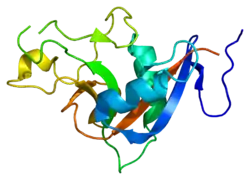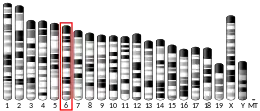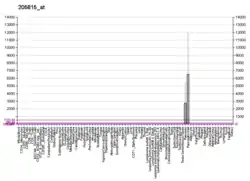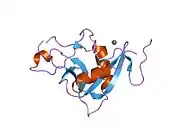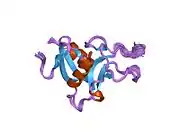REG3A
پروتئین ۳ آلفا بازسازیکنندهٔ مشتق از جزایر لوزالمعده (به انگلیسی: Regenerating islet-derived protein 3 alpha) یک پروتئین ۲۳ پپتیدی[4] است که در انسان توسط ژن «REG3A» کُدگذاری میشود.[5][6]
این مولکول، یک پروتئین ترشحی لوزالمعده است که در تمایز و رشد یاخته شرکت دارد و شباهتهایی با خانوادهٔ بزرگ لکتین نوع سی دارد. بیان ژن «REG3A» در جریان التهاب لوزالمعده و سرطان کبد افزایش مییابد.
این مولکول همچنین نوعی باکتریکش است که در در رودهها ترسح شده و فعالیت ضد باکتریهای گرم-مثبت دارد. خواص باکتریکشی این مولکول از طریق اتصال آن به کربوهیدراتهای دیوارهٔ پپتیدوگلیکانی باکتری انجام میشود.[7][8]
منابع
- GRCm38: Ensembl release 89: ENSMUSG00000071356 - Ensembl, May 2017
- "Human PubMed Reference:". National Center for Biotechnology Information, U.S. National Library of Medicine.
- "Mouse PubMed Reference:". National Center for Biotechnology Information, U.S. National Library of Medicine.
- Chakraborty C, Sharma S, Katsumata N, Murphy LJ, Schroedter IC, Robertson MC, Shiu RP, Friesen HG (Jun 1995). "Plasma clearance, tissue uptake and expression of pituitary peptide 23/pancreatitis-associated protein in the rat". Journal of Endocrinology. 145 (3): 461–9. doi:10.1677/joe.0.1450461. PMID 7636430.
- Dusetti NJ, Frigerio JM, Fox MF, Swallow DM, Dagorn JC, Iovanna JL (Jun 1994). "Molecular cloning, genomic organization, and chromosomal localization of the human pancreatitis-associated protein (PAP) gene". Genomics. 19 (1): 108–14. doi:10.1006/geno.1994.1019. PMID 8188210.
- "Entrez Gene: REG3A regenerating islet-derived 3 alpha".
- Cash, Heather L.; Whitham, Cecilia V.; Behrendt, Cassie L.; Hooper, Lora V. (2006-08-25). "Symbiotic bacteria direct expression of an intestinal bactericidal lectin". Science. 313 (5790): 1126–1130. doi:10.1126/science.1127119. ISSN 1095-9203. PMC 2716667. PMID 16931762.
- Vaishnava, Shipra; Yamamoto, Miwako; Severson, Kari M.; Ruhn, Kelly A.; Yu, Xiaofei; Koren, Omry; Ley, Ruth; Wakeland, Edward K.; Hooper, Lora V. (2011-10-14). "The antibacterial lectin RegIIIγ promotes the spatial segregation of microbiota and host in the intestine". Science. 334 (6053): 255–258. doi:10.1126/science.1209791. ISSN 0036-8075. PMC 3321924. PMID 21998396.
- مشارکتکنندگان ویکیپدیا. «REG3A». در دانشنامهٔ ویکیپدیای انگلیسی.
برای مطالعهٔ بیشتر
- Lasserre C, Christa L, Simon MT, et al. (1992). "A novel gene (HIP) activated in human primary liver cancer". Cancer Res. 52 (18): 5089–95. PMID 1325291.
- Orelle B, Keim V, Masciotra L, et al. (1993). "Human pancreatitis-associated protein. Messenger RNA cloning and expression in pancreatic diseases". J. Clin. Invest. 90 (6): 2284–91. doi:10.1172/JCI116115. PMC 443380. PMID 1469087.
- Itoh T, Teraoka H (1993). "Cloning and tissue-specific expression of cDNAs for the human and mouse homologues of rat pancreatitis-associated protein (PAP)". Biochim. Biophys. Acta. 1172 (1–2): 184–6. doi:10.1016/0167-4781(93)90290-t. PMID 7679928.
- Itoh T, Sawabu N, Motoo Y, et al. (1995). "The human pancreatitis-associated protein (PAP)-encoding gene generates multiple transcripts through alternative use of 5' exons". Gene. 155 (2): 283–7. doi:10.1016/0378-1119(94)00799-X. PMID 7721106.
- Lasserre C, Simon MT, Ishikawa H, et al. (1994). "Structural organization and chromosomal localization of a human gene (HIP/PAP) encoding a C-type lectin overexpressed in primary liver cancer". Eur. J. Biochem. 224 (1): 29–38. doi:10.1111/j.1432-1033.1994.tb19991.x. PMID 8076648.
- Christa L, Carnot F, Simon MT, et al. (1997). "HIP/PAP is an adhesive protein expressed in hepatocarcinoma, normal Paneth, and pancreatic cells". Am. J. Physiol. 271 (6 Pt 1): G993–1002. doi:10.1152/ajpgi.1996.271.6.G993. PMID 8997243.
- Rafaeloff R, Pittenger GL, Barlow SW, et al. (1997). "Cloning and sequencing of the pancreatic islet neogenesis associated protein (INGAP) gene and its expression in islet neogenesis in hamsters". J. Clin. Invest. 99 (9): 2100–9. doi:10.1172/JCI119383. PMC 508040. PMID 9151782.
- Bödeker H, Keim V, Fiedler F, et al. (2000). "PAP I interacts with itself, PAP II, PAP III, and lithostathine/regIalpha". Mol. Cell Biol. Res. Commun. 2 (3): 150–4. doi:10.1006/mcbr.1999.0166. PMID 10662590.
- Graf R, Schiesser M, Scheele GA, et al. (2001). "A family of 16-kDa pancreatic secretory stress proteins form highly organized fibrillar structures upon tryptic activation". J. Biol. Chem. 276 (24): 21028–38. doi:10.1074/jbc.M010717200. PMID 11278730.
- Strausberg RL, Feingold EA, Grouse LH, et al. (2003). "Generation and initial analysis of more than 15,000 full-length human and mouse cDNA sequences". Proc. Natl. Acad. Sci. U.S.A. 99 (26): 16899–903. doi:10.1073/pnas.242603899. PMC 139241. PMID 12477932.
- Simon MT, Pauloin A, Normand G, et al. (2003). "HIP/PAP stimulates liver regeneration after partial hepatectomy and combines mitogenic and anti-apoptotic functions through the PKA signaling pathway". FASEB J. 17 (11): 1441–50. doi:10.1096/fj.02-1013com. PMID 12890698.
- Gerhard DS, Wagner L, Feingold EA, et al. (2004). "The Status, Quality, and Expansion of the NIH Full-Length cDNA Project: The Mammalian Gene Collection (MGC)". Genome Res. 14 (10B): 2121–7. doi:10.1101/gr.2596504. PMC 528928. PMID 15489334.
- Lieu HT, Batteux F, Simon MT, et al. (2005). "HIP/PAP accelerates liver regeneration and protects against acetaminophen injury in mice". Hepatology. 42 (3): 618–26. doi:10.1002/hep.20845. PMID 16116631.
- Rual JF, Venkatesan K, Hao T, et al. (2005). "Towards a proteome-scale map of the human protein-protein interaction network". Nature. 437 (7062): 1173–8. doi:10.1038/nature04209. PMID 16189514.
- Cash HL, Whitham CV, Behrendt CL, Hooper LV (2006). "Symbiotic Bacteria Direct Expression of an Intestinal Bactericidal Lectin". Science. 313 (5790): 1126–30. doi:10.1126/science.1127119. PMC 2716667. PMID 16931762.
- Ho MR, Lou YC, Lin WC, et al. (2006). "Human pancreatitis-associated protein forms fibrillar aggregates with a native-like conformation". J. Biol. Chem. 281 (44): 33566–76. doi:10.1074/jbc.M604513200. PMID 16963458.
| در ویکیانبار پروندههایی دربارهٔ REG3A موجود است. |
This article is issued from Wikipedia. The text is licensed under Creative Commons - Attribution - Sharealike. Additional terms may apply for the media files.
